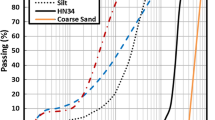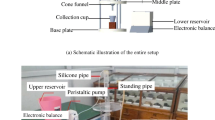Abstract
This study investigated the clogging process in coarse soil deposits in a dam foundation using natural soil media. The coarse soil deposits for this experimental study are divided into two types: graded soils with fine particles and graded soils without fine particles. The fine particle content, equivalent particle size, and clogging particle size are found to be vital factors affecting seepage deformation and clogging for the coarse soil deposits in the dam foundation. In experiments using graded soil media with some fines, clogging can effectively increase the content of fine particles in soil media, prevent the continuous development of seepage deformation, and enhance the seepage stability of soil media. For any particle size distribution in the coarse soil deposit, the equivalent particle size in D20 is the most suitable for calculating the optimum clogging particle size. The hydraulic conductivity for any size of incoming clogging particles, k, has an exponential relationship with the ratio of D20 squared and the product of Cu for the soil media and de for the equivalent particle size of clogging particles.









Similar content being viewed by others
Abbreviations
- PSD:
-
Particle size distribution
- PS:
-
Particle size
- C u :
-
Nonuniformity coefficient of soil media
- C c :
-
Curvature coefficient
- E1 E2 E3 E4:
-
Four different numbers of experiment with four different soil media particle size distribution
- K t :
-
The values of hydraulic conductivity at any time
- D 10 D 15 D 17 D 20 D 25 :
-
The diameter through which 10%, 15%, 17%, 20%, 25% of the total soil mass is passing for the soil media particles
- d 85 :
-
The diameter through which 85% of the total soil mass is passing for the clogging particles
- D e :
-
The equivalent particle size equals to (dmax × dmin)0.5
- d o10, d o15, d o17, d o20, d o25 :
-
The optimum clogging particles size under D10, D15, D17, D20, D25
- n :
-
The porosity of the soil media
- α :
-
The particle shape correction factor
- FPC:
-
Fine particle content
- D q :
-
The critical grain size of coarse-to-fine particles, equals to (D70 × D10)0.5
- CP, S, S-I, I, N:
-
Clogging patterns and S denotes clogging pattern of surface clogging, S-I denotes clogging pattern of surface-internal clogging, I denotes clogging pattern of internal partial pore blockage, N denotes clogging pattern of unclogging
- d c , d sc , d ic, d uc :
-
The clogging particle size of soil media, dsc denotes the PS forming the surface clogging pattern, dic denotes the PS forming the internal partial pore blockage pattern, duc denotes the PS that does not form clogging and D20 denotes the equivalent size of soil media particles
- a b :
-
The parameters in the hydraulic conductivity k, The diameter through which 20% of the total soil mass is passing for the soil media particles D20, the nonuniformity coefficient for soil media Cu, the equivalent size of incoming particles de
References
Aiello R et al (2016) Evaluation of clogging in full-scale subsurface flow constructed wetlands. Ecol Eng 95:505–513. https://doi.org/10.1016/j.ecoleng.2016.06.113
Alem A, Ahfir N, Elkawafi A, Wang H (2015) Hydraulic Operating Conditions and Particle Concentration Effects on Physical Clogging of a Porous Medium. Transp Porous Media 106(2):303–321. https://doi.org/10.1007/s11242-014-0402-8
ASTM D2434–68 (2006) Standard Test Method for Permeability of Granular Soils (Constant Head). ASTM International, West Conshohocken, PA
Berhane G, Amare M, Gebreyohannes T, Walraevens K (2017) Geological and geophysical investigation of water leakage from two micro-dam reservoirs: Implications for future site selection, northern Ethiopia. J Afr Earth Sc 129:82–93. https://doi.org/10.1016/j.jafrearsci.2016.12.015
Berhane G, Martens K, Al Farrah N, Walraevens K (2013) Water leakage investigation of micro-dam reservoirs in Mesozoic sedimentary sequences in Northern Ethiopia. J Afr Earth Sc 79:98–110. https://doi.org/10.1016/j.jafrearsci.2012.10.004
Faber S et al (2016) Migration and deposition of fine particles in a porous filter and alluvial deposit: laboratory experiments. Arab J Geosci 9(4):1–13. https://doi.org/10.1007/s12517-016-2309-x
Hatt BE, Fletcher TD, Deletic A (2008) Hydraulic and pollutant removal performance of fine media stormwater filtration systems. Environ Sci Technol 7(42):2535–2541. https://doi.org/10.1021/es071264p
Hua G, Kong J, Ji Y, Li M (2018) Influence of clogging and resting processes on flow patterns in vertical flow constructed wetlands. Sci Total Environ 621:1142–1150. https://doi.org/10.1016/j.scitotenv.2017.10.113
Hui Y, Ma H (1957) Hydraulics on granular materials. Water Conservancy Press, Beijing, pp 39–48
Jiang N (2014) An Application of Curtain Grouting in Seepage Prevention Treament of Dam Foundation of Awoduo reservoir in Tibet, Changchun
Kandra HS, McCarthy D, Fletcher TD, Deletic A (2014) Assessment of clogging phenomena in granular filter media used for stormwater treatment. J Hydrol 512:518–527. https://doi.org/10.1016/j.jhydrol.2014.03.009
Kenney TC, Chan HT (1973) Field investigation of permeability ratio of New Liskeard varved soil. Canadian Geotech J 10(3):473–438
Li S, Wang C, Wang G, Ma J (2013) Clogging types distinguishing of coarse-grained soil and determination of optimal range of clogging grain size. J Hydraul Eng 44(10):1217–1224
Li S, Wang C, Wang G, Ma J (2012) Infiltration clogging test and simulation by PFC3D for loose dam foundation. J Hydraul Eng 43(10):1163–1170
Li S, Wang C, Wang G, Zou T, Ma J (2016) Test and mechanism of seepage deformation for the looses dam foundation in the Shannan region of Tibet. Hydrogeol Eng Geol 43(1):57–63.93
Li SB, Liang H, Li H, Ma JQ, Li B (2021) Minimum void ratio model establishing of tailings and determination of optimal void ratio. Geofluids, Article ID 8619121, 2021. https://doi.org/10.1155/2021/8619121
Li X, Chen Y, Hu R, Yang Z (2017) Towards an optimization design of seepage control: A case study in dam engineering. SCIENCE CHINA Technol Sci 60(12):1903–1916
Liu J, Xie D (2012) Research on seepage stability experiment of gravelly soil. Yantu Lixue/rock and Soil Mechanics 33(9):2632–2638
Liu J (2006) Seepage Control of Earth-Rock Dams Theoretical Basis. Engineering Experiences and Lessons. China Water & Power Press, Beijing, China, pp 12–48
Ma J, Li S (2018) Seepage Control Design for the Looses Dam Foundation of Zhuoyu Reservoir in Tibet. Science Technology and Engineering 18(10):136–143
Ma J, Peng H, Li S et al (2020) (2020) Exploring the Occurrence of Clogging in Highly Permeable Coarse Soils of Dam Foundations. Advances in Civil Engineering 3:1–16. https://doi.org/10.1155/2020/8868052
Ozcelik M, Tuzlu F (2018) Leakage Analysis of Deriner Dam (Artvin-Turkey) Using 3D Modelingpdf. J Civ Eng 22(8):2916–2922. https://doi.org/10.1061/(ASCE)1090-0241(2007)133:8(1026)
Rowe MIRK, Asce F (2007) Clogging of Gravel Drainage Layers Permeated with Landfill Leachate. Journal of Geotechnical and Geoenvironmental Engineering 133(8):1026–1039. https://doi.org/10.1061/(ASCE)1090-0241(2007)133:8(1026)
Sañudo-Fontaneda LA, Coupe SJ, Charlesworth SM, Rowlands EG (2018) Exploring the effects of geotextiles in the performance of highway filter drains. Geotext Geomembr 46(5):559–565. https://doi.org/10.1016/j.geotexmem.2018.04.006
Sherard JL, Dunnigan LP, Talbot JR (1984) Basic Properties of Sand and Gravel Filters. Journal of Geotechnical Engineering 6(110):684–700. https://doi.org/10.1061/(ASCE)0733-9410(1984)110:6(684)
Terzaghi K, Peck RB, Mesri G (1996) Soil Mechanics in Engineering Practice, 3rd edn. Wiley-Interscience, New York, p 592
Wang G, Huang C (2009) Seepage analysis for dam foundation and abutment of Jiangxiong reservior and its leakage-proof plan evaluation. Global Geology 28(3):367–370
Wang Z, Du X, Yang Y (2012) Surface clogging process modeling of suspended solids during urban stormwater aquifer recharge. J Environ Sci 24(8):1418–1424. CNKI:SUN:HJKB.0.2012-08-010
Wei G (2003) Application of transient surface wave technology in seepage reconnaissance of Tibet Qiongguo reservoir. Water Resouices & Hydropower of Northeast 21(09):51–52+56
Wiese B, Nützmann G (2009) Transient leakance and infiltration characteristics during lake bank filtration. Ground Water 47(1):57-68
Yang M, Lu M, Bian H, Sheng L, He C (2017) Effects of clogging on hydraulic behavior in a vertical-flow constructed wetland system: A modelling approach. Ecol Eng 109:41–47. https://doi.org/10.1016/j.ecoleng.2017.09.010
Yao ChD (1996) Study on Leakage of Dam Foundation of Darando Reservoir by Using Water Oxygen Content. Chinese Journal of Radiological Medicine and Protection 16:1
Yousif OSQ, Karakouzian M, Rahim NOA, Rashed KA (2017) Physical Clogging of Uniformly Graded Porous Media Under Constant Flow rates. Transp Porous Media 120(3):643–659. https://doi.org/10.1007/s11242-017-0946-5
Zhang G (2008) Experimental study of clogging effect on permeability of dam foundation soil for plateau reservoir, Jilin university, pp100
Zhang J (1992) Anti-Seepage and Grouting of Dam Foundation. China Water&Power Press, Beijing, pp 8–13
Zhao Y, Wang G, Wang C (2006) Analysis and evaluation of seepage for dam area of Jiangxiong Reservoir in Tibet. Haihe Water Resources (05):61–62+70
Zheng G, Cao J, Cheng X, Ha D, Wang F (2018) Experimental study on the artificial recharge of semiconfined aquifers involved in deep excavation engineering. J Hydrol 557:868–877. https://doi.org/10.1016/j.jhydrol.2018.01.020
Acknowledgements
The authors would like to thank Professor Changming Wang and professor Gangcheng Wang, Construction Engineering College of Jilin University, for the technical support provided for this research. The authors are also thankful to the reviewers for their valuable comments and suggestions.
Funding
This work was supported by the National Natural Science Foundation of China (Nos. 41602359, 41907255, 41807190, and 41702298) and the Project Supported by Natural Science Basic Research Plan in Shaanxi Province of China (Nos. 2017JQ4019 and 2017JQ4020).
Author information
Authors and Affiliations
Corresponding author
Rights and permissions
About this article
Cite this article
Ma, J., Zhao, X., Li, S. et al. Exploring the clogging process in coarse soil deposits in a dam foundation. Bull Eng Geol Environ 81, 16 (2022). https://doi.org/10.1007/s10064-021-02533-7
Received:
Accepted:
Published:
DOI: https://doi.org/10.1007/s10064-021-02533-7




